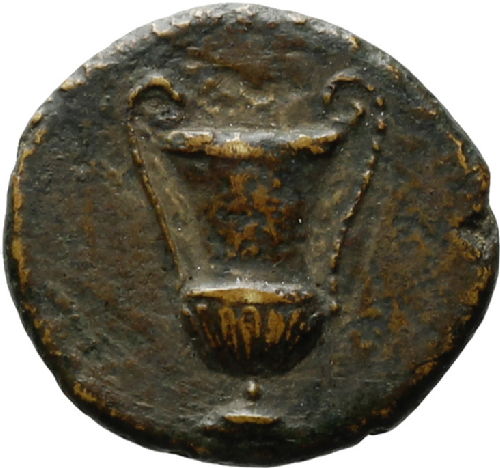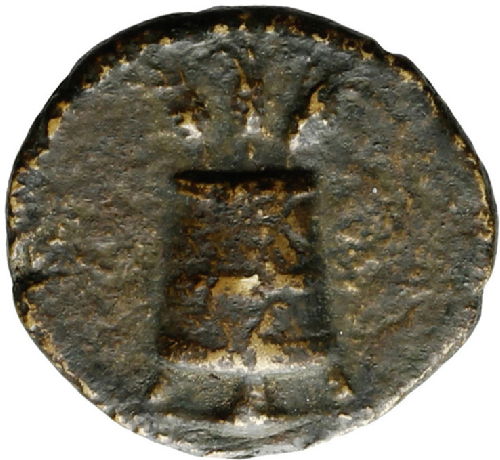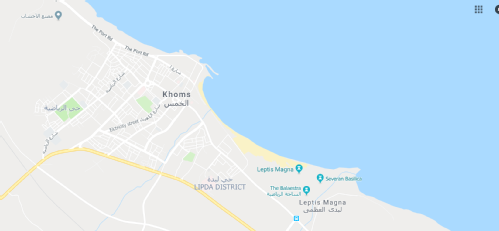All 1 entries tagged Leptis Magna
No other Warwick Blogs use the tag Leptis Magna on entries | View entries tagged Leptis Magna at Technorati | There are no images tagged Leptis Magna on this blog
December 20, 2017
Charon's obol and the brass tokens of Lepcis Magna
 |
 |
Brass token in the Ashmolean Museum. A kantharus is shown on one side and a modius with three grain-ears emerging out the top on the other. (Cohen VIII p. 272 no. 55)
Amongst the Roman tokens issued in brass (orichalcum) is a series that displays a kantharus (drinking cup) on one side and a modius (a container for wheat or corn) on the other (Cohen VIII p. 272 no. 55). Brass or orichalcum was a metal also used to make Roman imperial coinage, and the use of the metal here, alongside the high quality of the design, suggests that perhaps this series of tokens was made at the Roman mint at the request of an individual or group.
Although we don’t know the precise function this token was made for, we do possess some remarkable information about some of their later lives. During archaeological survey work by Roma Tre University around the North African city of Lepcis Magna FOUR of these tokens were found in tombs surrounding the city, between Lepcis and Khoms. Only this type of token, no other token types, were discovered.

Google Map showing Lepcis Magna and Khoms.
One token was found in a disturbed hypogeum tomb near Gasr Gelda; the other contents of the tomb suggest the structure was used from the Flavian period until the mid second century AD. A second token was found in another hypogeum west of Wadi er-Rsaf, again dated to the second century AD on the basis of other finds (mainly ceramics). The token in this tomb was found in a coffin-shaped urn with faint red letters that named the deceased as Tiberius Claudius Orfitus. The bones in the urn were those of an adult male; the Tiberii Claudii were a family of elevated social rank in the city of Lepcis Magna in the first and second centuries AD. Two additional tokens with the kantharus and modius design were found in hypogeum tombs in Khoms, also in use between the Flavian period and second century AD (mention is also made of a fifth token of this type).
It is extraordinary that so many brass tokens of the same type should be found around the city of Lepcis Magna; this type of object is a relatively rare archaeological find in the Mediterranean. It suggests that at some point in the second century AD a series of these particular tokens arrived in the city, perhaps brought back by merchants or contained in a shipment of small change. These tokens, being the same metal and the same size as Roman coins, may have come to circulate as small change after their initial use. Amongst the coin finds from the tombs were anonymous quadrantes (the smallest coin denomination) and here too there were multiple finds of the same type (e.g. four examples of RIC II 19, with the helmeted head of Mars on the obverse and a cuirass with the letters S C on the reverse). This suggests that there was a shipment of small change to the town, which may have included these brass tokens. Whatever their original use, these tokens, looking and feeling like coinage, were pressed into service to ensure the liquidity of the Roman economy.
In the Greek and Roman worlds one needed to be buried with a coin in order to pay the ferryman to cross into the underworld, and the coin buried with the deceased was called “Charon’s obol”. This is why many burials from the Greek and Roman worlds contain one coin (or coin like object); some even contain more than one! The tokens found in these tombs thus acquired a third use - to cross into the underworld. They were likely chosen because they were a small denomination; they may have also been selected for this use because they looked slightly different from other coins, but this is much more speculative.
These contexts are important in that they suggest a date for this type of token - they were likely created towards the end of the first century AD, or in the first half of the second century.
This blog was written by Clare Rowan as part of the Token Communities in the Ancient Mediterranean Project.
Bibliography:
Di Vita-Evrard, G., L. Musso, F. Mallegni and S. Fontana (1996). L'ipogeo dei Flavi a Leptis Magna presso Gasr Gelda. Libya Antiqua 2: 85-134.
Di Vita-Evrard, G., S. Fontana and M. Munzi (1997). Le necropoli di Leptis Magna III. Une tombe hypogée de la nécropole occidentale: Laurentii ou Claudii? Libya Antiqua 3: 119-138.
Munzi, M. (1997). Quadranti anonimi e tessere monetali dalle tombe di Leptis Magna. Annotazione Numismatische 26: 589-593.
 Clare Rowan
Clare Rowan

 Please wait - comments are loading
Please wait - comments are loading

 Loading…
Loading…

